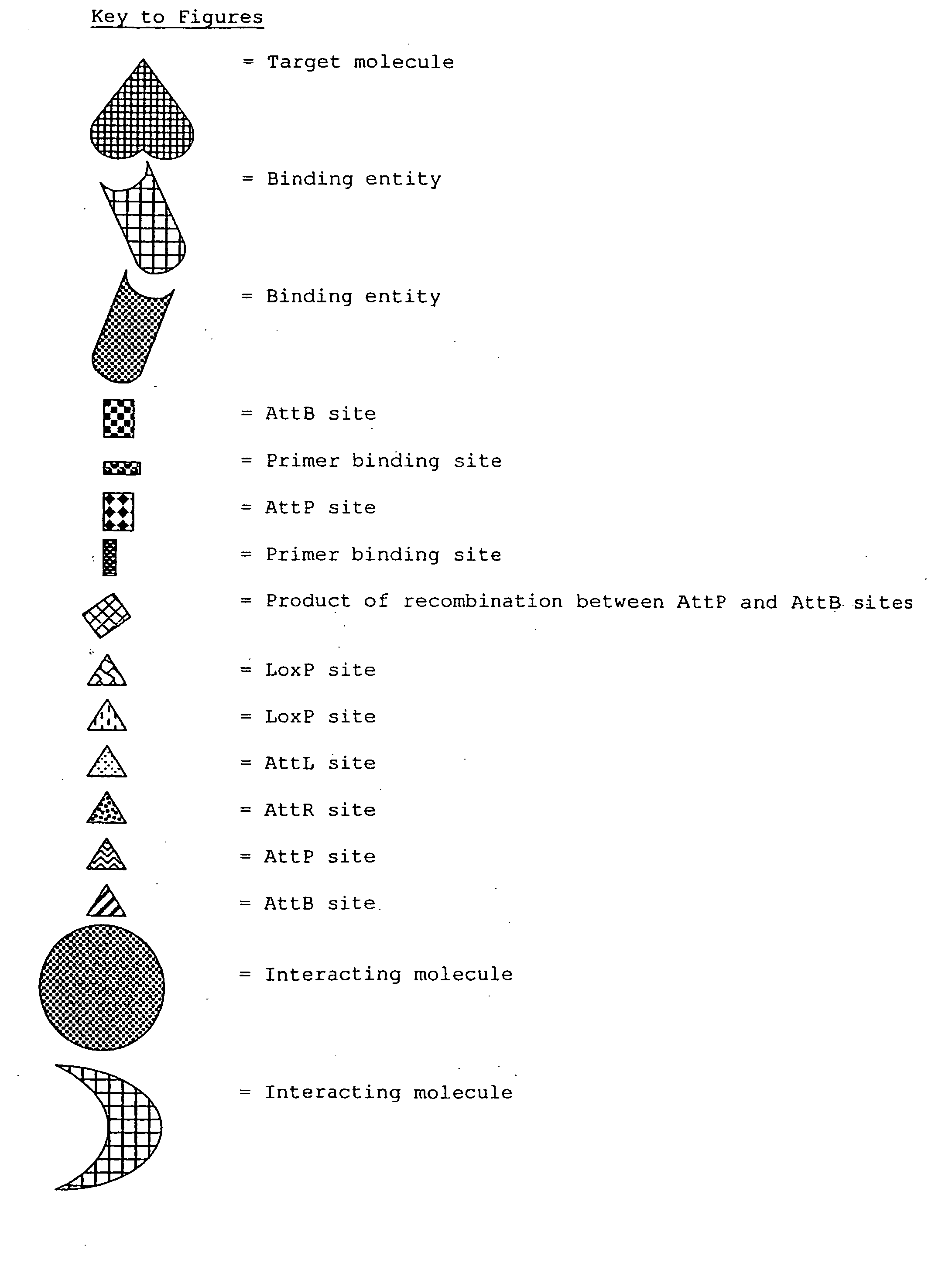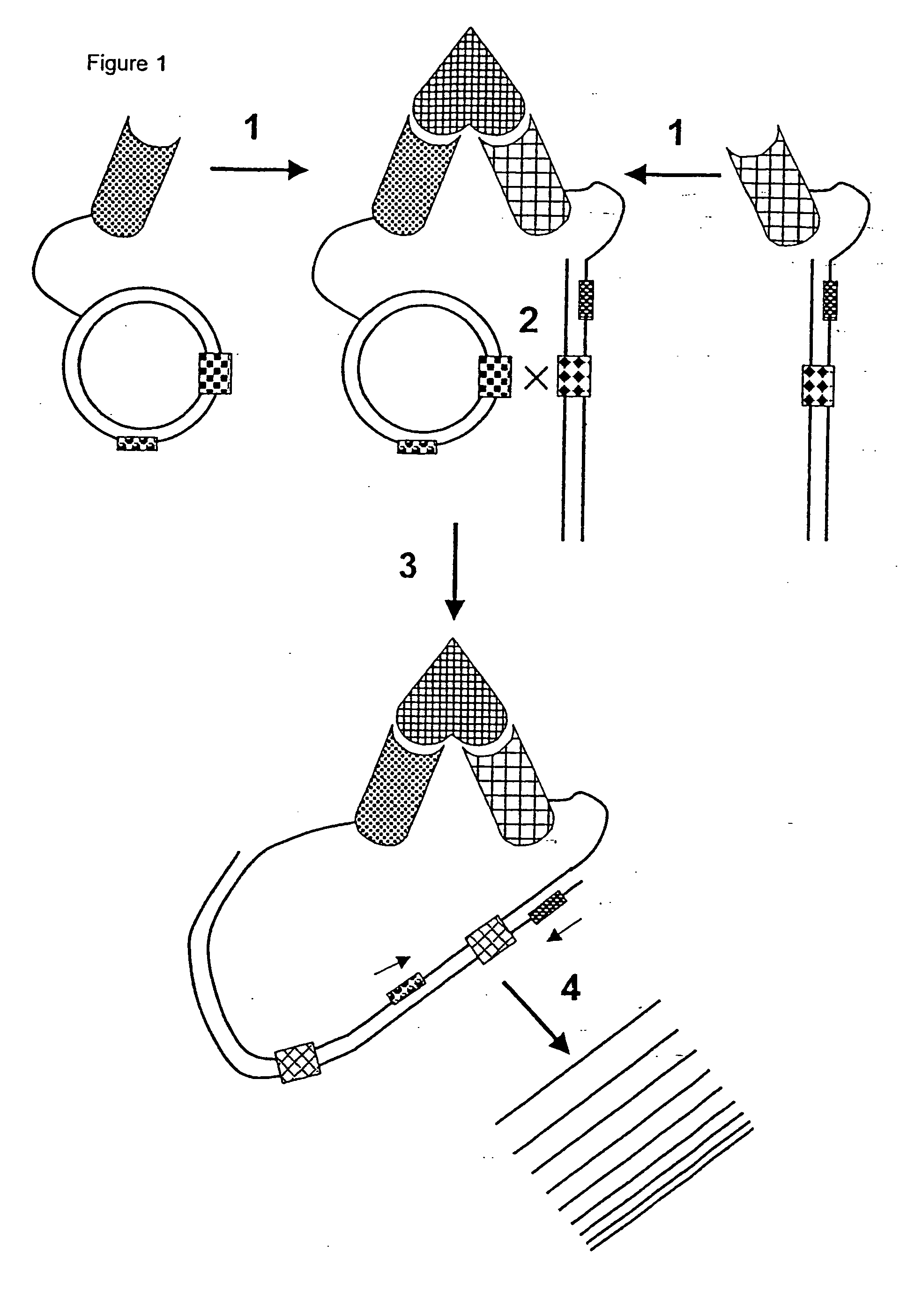Methods for detection of target molecules and molecular interactions
a molecular interaction and target molecule technology, applied in the field of target molecule and molecular interaction detection methods, can solve the problems of inefficient ligation reaction, high specificity loss of detection, complex method and other problems, to achieve the effect of reducing background signal, improving sensitivity and reproducibility of method, and being more amenable to automation
- Summary
- Abstract
- Description
- Claims
- Application Information
AI Technical Summary
Benefits of technology
Problems solved by technology
Method used
Image
Examples
example 1
Demonstration of Target-Enhanced Recombination Between DNA Molecules Labeled with Target-Specific Ligands
[0100] This experiment illustrates that recombination between two molecules of double stranded DNA is enhanced when the two DNA molecules are-brought into close proximity through binding to a target molecule. In this example the DNA strands are derivatised with biotin which acts as a ligand for the target molecule, streptavidin (each molecule of streptavidin can bind four biotin ligands).
[0101] 1. The bacteriophage integrase (a phage specific recombinase) signal sequences, attL and attR, necessary for recombination were amplified using the polymerase chain reaction (PCR) from two commercially available plasmids containing these sequences. The PCR primers contained amino terminal groups to allow subsequent chemical derivatisation of the PCR product.
[0102] 2. The PCR products were agarose gel purified using standard techniques and biotinylated using 0.5 mg of biotinamidohexanoic ac...
example 2
Demonstration of Molecular Interactions Through Enhanced Recombination Between DNA Molecules Attached to the Interacting Molecules
[0113] This experiment illustrates that recombination can be used to monitor molecular interactions. The two reactants are tagged with double stranded DNA. When the molecules interact the two DNA molecules are brought to close proximity and the recombination between them is enhanced. In this example, we have monitored the interaction of streptavidin tagged with one double strand of DNA and biotin tagged with the other double strand of DNA.
[0114] 1. The bacteriophage integrase (a phage specific recombinase) signal sequences, attL and attR, necessary for recombination were amplified using the polymerase chain reaction (PCR) from two commercially available plasmids containing these sequences. The PCR primers contained amino terminal groups to allow subsequent chemical derivatisation of the PCR product.
[0115] 2. The PCR products were agarose gel purified usin...
example 3
[0128] EXAMPLE 3
Demonstration of Target-Specific Recombination Between DNA Molecules Labeled with Target-Specific Ligands
[0129] This experiment illustrates that recombination between two molecules of double stranded DNA is enhanced when the two DNA molecules are brought to close proximity through binding to a target molecule. In this example the DNA strands are derivatised with biotin which acts as a ligand for the target molecule, streptavidin (each molecule of streptavidin can bind four biotin ligands). In this example the target is immobilized onto a solid surface before detection.
[0130] 1. The bacteriophage integrase (a phage-specific recombinase) signal sequences, attL and attR, necessary for recombination were amplified using the polymerase chain reaction (PCR) from two commercially available plasmids containing these sequences. The PCR primers contained amino terminal groups to allow subsequent chemical derivatisation of the PCR product.
[0131] 2. The PCR products were agarose...
PUM
| Property | Measurement | Unit |
|---|---|---|
| nucleic acid | aaaaa | aaaaa |
| real-time | aaaaa | aaaaa |
| 100 nucleic acid | aaaaa | aaaaa |
Abstract
Description
Claims
Application Information
 Login to View More
Login to View More - R&D
- Intellectual Property
- Life Sciences
- Materials
- Tech Scout
- Unparalleled Data Quality
- Higher Quality Content
- 60% Fewer Hallucinations
Browse by: Latest US Patents, China's latest patents, Technical Efficacy Thesaurus, Application Domain, Technology Topic, Popular Technical Reports.
© 2025 PatSnap. All rights reserved.Legal|Privacy policy|Modern Slavery Act Transparency Statement|Sitemap|About US| Contact US: help@patsnap.com



